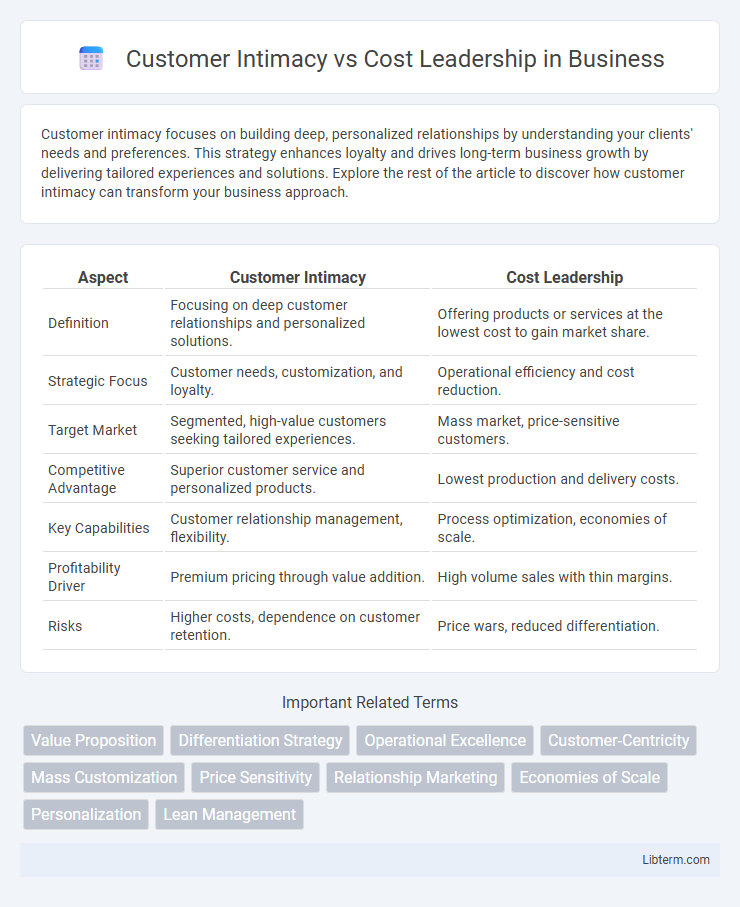Customer intimacy focuses on building deep, personalized relationships by understanding your clients' needs and preferences. This strategy enhances loyalty and drives long-term business growth by delivering tailored experiences and solutions. Explore the rest of the article to discover how customer intimacy can transform your business approach.
Table of Comparison
| Aspect | Customer Intimacy | Cost Leadership |
|---|---|---|
| Definition | Focusing on deep customer relationships and personalized solutions. | Offering products or services at the lowest cost to gain market share. |
| Strategic Focus | Customer needs, customization, and loyalty. | Operational efficiency and cost reduction. |
| Target Market | Segmented, high-value customers seeking tailored experiences. | Mass market, price-sensitive customers. |
| Competitive Advantage | Superior customer service and personalized products. | Lowest production and delivery costs. |
| Key Capabilities | Customer relationship management, flexibility. | Process optimization, economies of scale. |
| Profitability Driver | Premium pricing through value addition. | High volume sales with thin margins. |
| Risks | Higher costs, dependence on customer retention. | Price wars, reduced differentiation. |
Understanding Customer Intimacy: Definition and Key Features
Customer intimacy is a business strategy that prioritizes deep relationships with customers to deliver tailored solutions and exceptional service, enhancing customer loyalty and lifetime value. Key features include personalized interactions, comprehensive customer insights, and adaptive offerings that meet specific needs and preferences. This approach contrasts with cost leadership by emphasizing quality and customization over low prices.
What is Cost Leadership? Core Principles Explained
Cost Leadership is a competitive strategy focused on becoming the lowest-cost producer in an industry to gain market share by offering lower prices. Core principles include efficient scale operations, tight cost control, minimization of overhead, and leveraging economies of scale and scope. Businesses adopting cost leadership aim to maintain quality while reducing costs through optimized supply chains, standardized processes, and technology investments.
Customer Intimacy vs Cost Leadership: An Overview
Customer intimacy emphasizes tailoring products and services to meet individual customer needs through personalized experiences, fostering loyalty and long-term relationships. In contrast, cost leadership focuses on achieving the lowest operational costs to offer competitive pricing, appealing to price-sensitive markets. Businesses choosing between customer intimacy and cost leadership must align their strategy with market demands, balancing customization with efficiency to maximize profitability.
Benefits of Customer Intimacy Strategy
Customer intimacy strategy fosters deep relationships with customers by tailoring products and services to meet specific needs, resulting in increased customer loyalty and higher lifetime value. This approach enables companies to capture detailed customer insights, driving innovation and personalized experiences that differentiate the brand in competitive markets. Businesses employing customer intimacy often achieve premium pricing and reduced churn rates due to enhanced trust and satisfaction.
Advantages and Drawbacks of Cost Leadership
Cost Leadership strategy offers advantages such as economies of scale, enabling companies to produce goods or services at lower costs and attract price-sensitive customers, thereby increasing market share. However, drawbacks include the risk of reduced product differentiation and potential vulnerability to price wars, which can erode profit margins. Firms reliant on cost leadership may also face challenges in adapting to changing consumer preferences that demand higher quality or innovation.
Key Differences between Customer Intimacy and Cost Leadership
Customer intimacy emphasizes personalized customer relationships and tailored solutions, prioritizing customer satisfaction and loyalty over price. Cost leadership focuses on achieving the lowest operational costs to offer competitive pricing and maximize market share through efficiency and scale. The key difference lies in customer intimacy driving value through differentiation and customization, while cost leadership drives value through cost reduction and standardized offerings.
Real-World Examples: Companies Practicing Each Strategy
Amazon exemplifies cost leadership by leveraging advanced supply chain technologies and vast economies of scale to offer competitive prices and fast delivery. Apple focuses on customer intimacy through personalized product design, premium customer service, and ecosystem integration, fostering strong brand loyalty. Walmart also practices cost leadership by optimizing logistics and minimizing operational costs to provide everyday low prices to a broad customer base.
Choosing the Right Approach: Factors to Consider
Choosing between customer intimacy and cost leadership depends on factors such as target market preferences, competitive landscape, and resource capabilities. Customer intimacy suits businesses aiming for personalized service and long-term relationships, while cost leadership benefits those targeting price-sensitive segments with operational efficiency. Assessing industry demands, company strengths, and customer expectations ensures alignment with the optimal strategic approach.
Can Customer Intimacy and Cost Leadership Coexist?
Customer intimacy and cost leadership can coexist when a company strategically segments its operations to deliver personalized customer experiences while maintaining efficient cost structures. By leveraging technology and data analytics, businesses optimize processes to reduce expenses without compromising on tailored services that enhance customer loyalty. Successful integration of these strategies requires aligning organizational resources to balance value creation with competitive pricing.
Future Trends in Competitive Business Strategies
Future trends in competitive business strategies highlight a growing shift toward hybrid models that blend customer intimacy with cost leadership to achieve sustainable advantage. Companies increasingly leverage advanced data analytics and AI-driven personalization to enhance customer experiences while simultaneously optimizing supply chains and operational efficiency to reduce costs. Embracing digital transformation and agile methodologies enables businesses to respond swiftly to market changes, balancing the dual imperatives of customer-centricity and cost competitiveness.
Customer Intimacy Infographic

 libterm.com
libterm.com